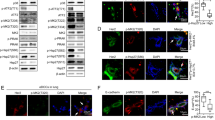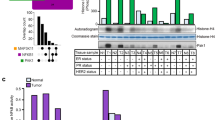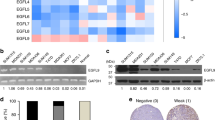Abstract
Discovery of mechanisms that impede the aggressive and metastatic phenotype of human basal triple-negative-type breast cancers (BTNBCs) could provide novel targets for therapy for this form of breast cancer that has a relatively poor prognosis. Previous studies have demonstrated that expression of GATA3, the master transcriptional regulator of mammary luminal differentiation, can reduce the tumorigenicity and metastatic propensity of the human BTNBC MDA-MB-231 cell line (MB231), although the mechanism for reduced metastases was not elucidated. We demonstrate through gene expression profiling that GATA3 expression in 231 cells resulted in the dramatic reduction in the expression of lysyl oxidase (LOX), a metastasis-promoting, matrix-remodeling protein, in part, through methylation of the LOX promoter. Suppression of LOX expression by GATA3 was further confirmed in the BTNBC Hs578T cell line. Conversely, reduction of GATA3 expression by small interfering RNA in luminal BT474 cells increased LOX expression. Reconstitution of LOX expression in 231-GATA3 cells restored metastatic propensity. A strong inverse association between LOX and GATA3 expression was confirmed in a panel of 51 human breast cancer cell lines. Similarly, human breast cancer microarray data demonstrated that high LOX/low GATA3 expression is associated with the BTNBC subtype of breast cancer and poor patient prognosis. Expression of GATA3 reprograms BTNBCs to a less aggressive phenotype and inhibits a major mechanism of metastasis through inhibition of LOX. Induction of GATA3 in BTNBC cells or novel approaches that inhibit LOX expression or activity could be important strategies for treating BTNBCs.
This is a preview of subscription content, access via your institution
Access options
Subscribe to this journal
Receive 50 print issues and online access
$259.00 per year
only $5.18 per issue
Buy this article
- Purchase on Springer Link
- Instant access to full article PDF
Prices may be subject to local taxes which are calculated during checkout






Similar content being viewed by others
References
Abourbih DA, Di CS, Orellana ME, Antecka E, Martins C, Petruccelli LA et al. (2010). Lysyl oxidase expression and inhibition in uveal melanoma. Melanoma Res 20: 97–106.
Asselin-Labat ML, Sutherland KD, Barker H, Thomas R, Shackleton M, Forrest NC et al. (2007). Gata-3 is an essential regulator of mammary-gland morphogenesis and luminal-cell differentiation. Nat Cell Biol 9: 201–209.
Barkan D, El Touny LH, Michalowski AM, Smith JA, Chu I, Davis AS et al. (2010). Metastatic growth from dormant cells induced by a col-I-enriched fibrotic environment. Cancer Res 70: 5706–5716.
Barkan D, Kleinman H, Simmons JL, Asmussen H, Kamaraju AK, Hoenorhoff MJ et al. (2008). Inhibition of metastatic outgrowth from single dormant tumor cells by targeting the cytoskeleton. Cancer Res 68: 6241–6250.
Bondareva A, Downey CM, Ayres F, Liu W, Boyd SK, Hallgrimsson B et al. (2009). The lysyl oxidase inhibitor, beta-aminopropionitrile, diminishes the metastatic colonization potential of circulating breast cancer cells. PLoS One 4: e5620–e562.
Chu I, Blackwell K, Chen S, Slingerland J . (2005). The dual ErbB1/ErbB2 inhibitor, lapatinib (GW572016), cooperates with tamoxifen to inhibit both cell proliferation- and estrogen-dependent gene expression in antiestrogen-resistant breast cancer. Cancer Res 65: 18–25.
Condeelis J, Pollard JW . (2006). Macrophages: obligate partners for tumor cell migration, invasion, and metastasis. Cell 124: 263–266.
Dydensborg AB, Rose AA, Wilson BJ, Grote D, Paquet M, Giguere V et al. (2009). GATA3 inhibits breast cancer growth and pulmonary breast cancer metastasis. Oncogene 28: 2634–2642.
Erler JT, Bennewith KL, Cox TR, Lang G, Bird D, Koong A et al. (2009). Hypoxia-induced lysyl oxidase is a critical mediator of bone marrow cell recruitment to form the premetastatic niche. Cancer Cell 15: 35–44.
Erler JT, Bennewith KL, Nicolau M, Dornhofer N, Kong C, Le QT et al. (2006). Lysyl oxidase is essential for hypoxia-induced metastasis. Nature 440: 1222–1226.
Grimsby JL, Lucero HA, Trackman PC, Ravid K, Kagan HM . (2010). Role of lysyl oxidase propeptide in secretion and enzyme activity. J Cell Biochem 111: 1231–1243.
Gupta GP, Massague J . (2006). Cancer metastasis: building a framework. Cell 127: 679–695.
Hennessy BT, Gonzalez-Angulo AM, Stemke-Hale K, Gilcrease MZ, Krishnamurthy S, Lee JS et al. (2009). Characterization of a naturally occurring breast cancer subset enriched in epithelial-to-mesenchymal transition and stem cell characteristics. Cancer Res 69: 4116–4124.
Hoenerhoff MJ, Chu I, Barkan D, Liu ZY, Datta S, Dimri GP et al. (2009). BMI1 cooperates with H-RAS to induce an aggressive breast cancer phenotype with brain metastases. Oncogene 28: 3022–3032.
Kagan HM, Li W . (2003). Lysyl oxidase: properties, specificity, and biological roles inside and outside of the cell. J Cell Biochem 88: 660–672.
Kaneda A, Wakazono K, Tsukamoto T, Watanabe N, Yagi Y, Tatematsu M et al. (2004). Lysyl oxidase is a tumor suppressor gene inactivated by methylation and loss of heterozygosity in human gastric cancers. Cancer Res 64: 6410–6415.
Kouros-Mehr H, Bechis SK, Slorach EM, Littlepage LE, Egeblad M, Ewald AJ et al. (2008). GATA-3 links tumor differentiation and dissemination in a luminal breast cancer model. Cancer Cell 13: 141–152.
Kouros-Mehr H, Slorach EM, Sternlicht MD, Werb Z . (2006a). GATA-3 maintains the differentiation of the luminal cell fate in the mammary gland. Cell 127: 1041–1055.
Kouros-Mehr H, Werb Z . (2006b). Candidate regulators of mammary branching morphogenesis identified by genome-wide transcript analysis. Dev Dyn 235: 3404–3412.
Levental KR, Yu H, Kass L, Lakins JN, Egeblad M, Erler JT et al. (2009). Matrix crosslinking forces tumor progression by enhancing integrin signaling. Cell 139: 891–906.
Minn AJ, Gupta GP, Siegel PM, Bos PD, Shu W, Giri DD et al. (2005). Genes that mediate breast cancer metastasis to lung. Nature 436: 518–524.
Neve RM, Chin K, Fridlyand J, Yeh J, Baehner FL, Fevr T et al. (2006). A collection of breast cancer cell lines for the study of functionally distinct cancer subtypes. Cancer Cell 10: 515–527.
Palamakumbura AH, Trackman PC . (2002). A fluorometric assay for detection of lysyl oxidase enzyme activity in biological samples. Anal Biochem 300: 245–251.
Palamakumbura AH, Vora SR, Nugent MA, Kirsch KH, Sonenshein GE, Trackman PC . (2009). Lysyl oxidase propeptide inhibits prostate cancer cell growth by mechanisms that target FGF-2-cell binding and signaling. Oncogene 28: 3390–3400.
Payne SL, Fogelgren B, Hess AR, Seftor EA, Wiley EL, Fong SF et al. (2005). Lysyl oxidase regulates breast cancer cell migration and adhesion through a hydrogen peroxide-mediated mechanism. Cancer Res 65: 11429–11436.
Payne SL, Hendrix MJ, Kirschmann DA . (2007). Paradoxical roles for lysyl oxidases in cancer—a prospect. J Cell Biochem 101: 1338–1354.
Perou CM, Sorlie T, Eisen MB, van de RM, Jeffrey SS, Rees CA et al. (2000). Molecular portraits of human breast tumours. Nature 406: 747–752.
Sorlie T, Tibshirani R, Parker J, Hastie T, Marron JS, Nobel A et al. (2003). Repeated observation of breast tumor subtypes in independent gene expression data sets. Proc Natl Acad Sci USA 100: 8418–8423.
Usary J, Llaca V, Karaca G, Presswala S, Karaca M, He X et al. (2004). Mutation of GATA3 in human breast tumors. Oncogene 23: 7669–7678.
van de Vijver MJ, He YD, van't Veer LJ, Dai H, Hart AA, Voskuil DW et al. (2002). A gene-expression signature as a predictor of survival in breast cancer. N Engl J Med 347: 1999–2009.
van't Veer LJ, Dai H, van d V, He YD, Hart AA, Mao M et al. (2002). Gene expression profiling predicts clinical outcome of breast cancer. Nature 415: 530–536.
Wang Y, Klijn JG, Zhang Y, Sieuwerts AM, Look MP, Yang F et al. (2005). Gene-expression profiles to predict distant metastasis of lymph-node-negative primary breast cancer. Lancet 365: 671–679.
Yan W, Cao QJ, Arenas RB, Bentley B, Shao R . (2010). GATA3 inhibits breast cancer metastasis through the reversal of epithelial–mesenchymal transition. J Biol Chem 285: 14042–14051.
Zhou M, Ouyang W . (2003). The function role of GATA-3 in Th1 and Th2 differentiation. Immunol Res 28: 25–37.
Acknowledgements
We thank Drs Lalage Wakefield and Li Yang for helpful scientific discussions. We also thank Lara El-Touny, Dalit Barkan, Zi-Yao Liu, TingHu Qiu, Anthony Vieira, Christina Bennett, Christine Tomlinson, Steven Austin, Christian Mustroph and Wei-Chu Lai for technical assistance; Paul Meltzer for sharing unpublished data; the LRBGE Fluorescence Imaging Core and Chand Khanna for the use of fluorescence microscopy equipment; and Julie Foley and Norris Flagler for technical assistance with image analysis. This research was supported in part by the Intramural Research Program, Center for Cancer Research, NCI, NIH. IMC acknowledges support from the Department of Defense Breast Cancer Research Program (W81XWH-10-2-0030).
Author information
Authors and Affiliations
Corresponding author
Ethics declarations
Competing interests
The authors declare no conflict of interest.
Additional information
Supplementary Information accompanies the paper on the Oncogene website
Rights and permissions
About this article
Cite this article
Chu, I., Michalowski, A., Hoenerhoff, M. et al. GATA3 inhibits lysyl oxidase-mediated metastases of human basal triple-negative breast cancer cells. Oncogene 31, 2017–2027 (2012). https://doi.org/10.1038/onc.2011.382
Received:
Revised:
Accepted:
Published:
Issue Date:
DOI: https://doi.org/10.1038/onc.2011.382
Keywords
This article is cited by
-
Value of Proline, Glutamic Acid, and Leucine-Rich Protein 1 and GATA Binding Protein 3 Expression in Breast Cancer: An Immunohistochemical study
Indian Journal of Surgery (2023)
-
The matrix in cancer
Nature Reviews Cancer (2021)
-
Lysyl oxidases: linking structures and immunity in the tumor microenvironment
Cancer Immunology, Immunotherapy (2020)
-
Comprehensive analysis of the GATA transcription factor gene family in breast carcinoma using gene microarrays, online databases and integrated bioinformatics
Scientific Reports (2019)
-
GATA-3 is superior to GCDFP-15 and mammaglobin to identify primary and metastatic breast cancer
Breast Cancer Research and Treatment (2018)



